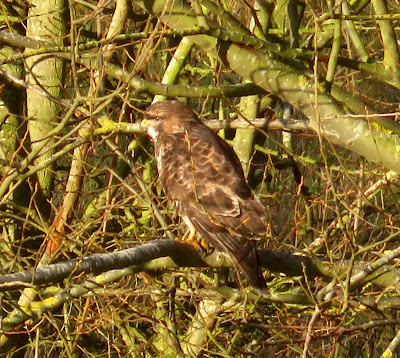Three stonechats were seen near the Maydays seawall along the Pyefleet on a dull Sunday 30th. There were two male birds and this female pictured above as it surveyed the ground around it.
Other small birds seen in the bushes and game cover corners were 4 yellowhammers, 40 linnets, 10 reed buntings, 10 chaffinches as well as 30+ fieldfares and 10 redwings.
One marsh harrier hunted over Reeveshall while another flew over the Maydays saltmarsh towards the Strood. Four marsh harriers were seen in the air together over Langenhoe Point. Four little egrets were seen on the Maydays saltmarsh.
The Pyefleet Channel at low tide looked very dull in the overcast and grey conditions. There were one or two big flocks of waders along the channel including 1500 dunlin, 500 lapwing, 700 golden plover, 50 knot, 300 redshank, 15 avocets with several grey plover, curlew as well as a greenshank heard calling. The only wildfowl noted were 200 brent geese, 50 shelduck and 50 wigeon.
A common seal was swimming in the channel by the Maydays creek.
On Monday 31st, a firecrest was discovered with a tit flock along the path at the top of the Firs Chase caravan site. I can't recall a firecrest being seen on the Island in mid-winter before.
At East Mersea the shorelark was seen on Sunday 30th and Monday 31st at the Point. At the end of Sunday Steve Entwistle saw 13 marsh harriers and a barn owl on Langenhoe, earlier at the park 18 redwing and 4 goldcrests. At West Mersea the great northern diver was seen on Saturday, Sunday and Monday.
On Monday 31st, a firecrest was discovered with a tit flock along the path at the top of the Firs Chase caravan site. I can't recall a firecrest being seen on the Island in mid-winter before.
At East Mersea the shorelark was seen on Sunday 30th and Monday 31st at the Point. At the end of Sunday Steve Entwistle saw 13 marsh harriers and a barn owl on Langenhoe, earlier at the park 18 redwing and 4 goldcrests. At West Mersea the great northern diver was seen on Saturday, Sunday and Monday.
The only small birds seen along the Strood seawall walk on Saturday 29th were ten reed buntings, one pictured above, also 40 linnets and 10 skylarks.
There was the usual variety of waders along the Strood channel during the low-tide walk on Saturday with the main waders of note being 200 lapwings and 50 golden plover near the Strood, 20 black-tailed godwits by the Dabchicks and an avocet from the Hard.
Two marsh harriers were on Feldy marsh and two common buzzards were over the field near the East Mersea junction at the Strood.
On Friday 28th a merlin was seen over the fields at Reeveshall, a sparrowhawk perched on a fencepost while four marsh harriers were on Langenhoe Point. In the channel were 4 red-breasted mergansers and four little grebes. Fifteen fieldfare perched on trees near Fishponds wood.
At the country park on Thursday 27th, the shorelark was still feeding on the beach at the East Mersea Point. Also 18 red-breasted mergansers in the river Colne and a common seal while 2 rock pipits flew over the seawall calling. In the fields were 400 brent geese, while 9 tufted duck and 18 gadwall were on the park pond and 5 fieldfare and 8 redwing were in trees by the clifftop.
The shorelark was feeding at the Point on Wednesday 26th, 12 red-breasted mergansers were in the Colne, 10 bar-tailed godwits flew past, 15 black-tailed godwits fed on the saltmarsh pools. A sparrowhawk flew over the fields, five little egrets at the park pond, four goldcrests were with the tit flock by the car park.
Whilst topping up the nut-feeder, the red squirrel appeared in the top of the tree so I had to beat a quick retreat leaving the ladder still propped up - which the squirrel soon checked over a few minutes later.
After having a drink of water, the red squirrel picked out a walnut from the feeder and then climbed up the tree and hid the nut away in a mass of needles on one of the cedar branches. It then came back for more feeds of nuts from the feeder before clambering up the tree and over into the neighbours.







































